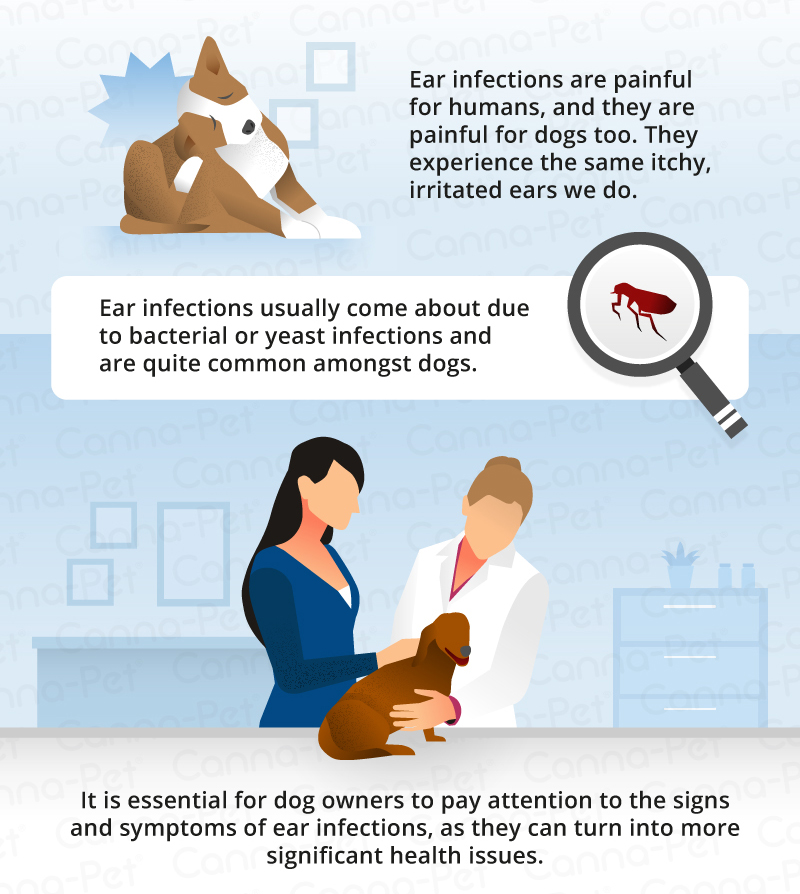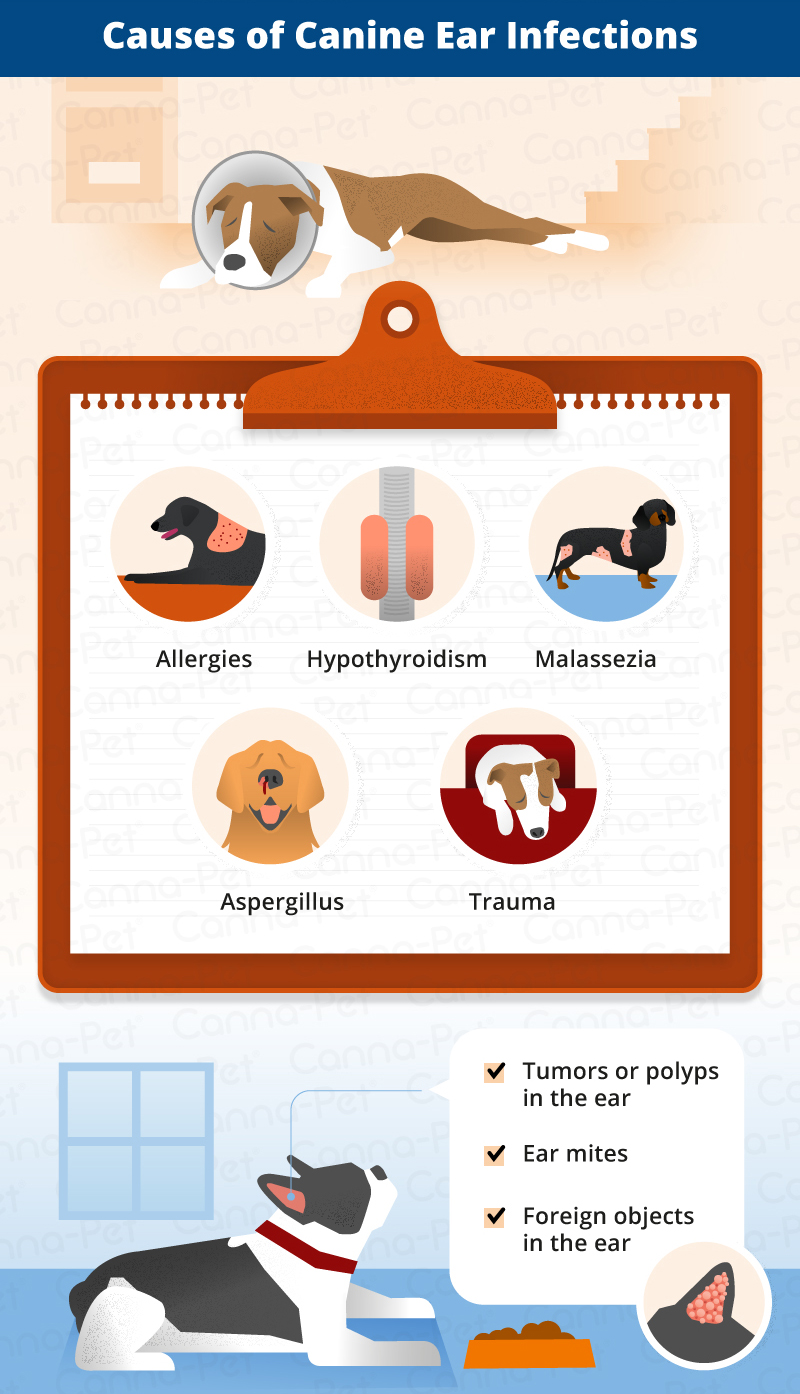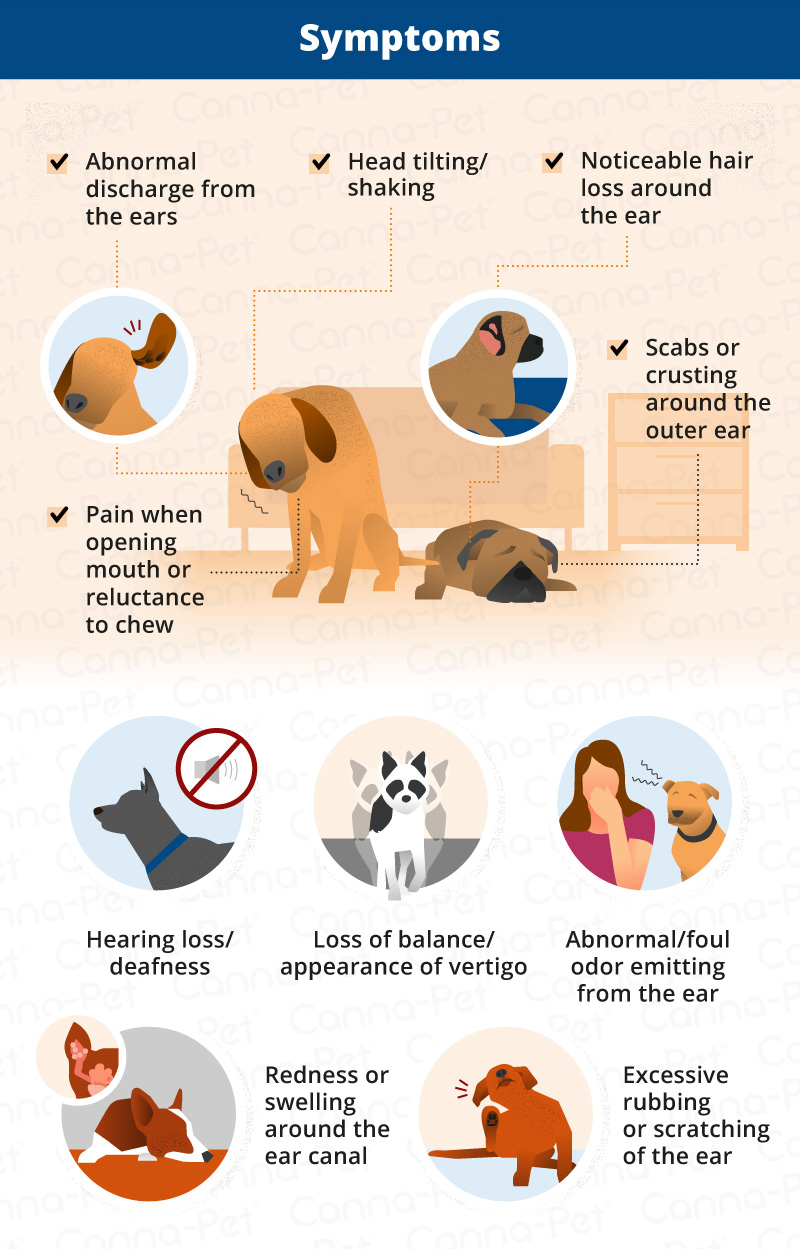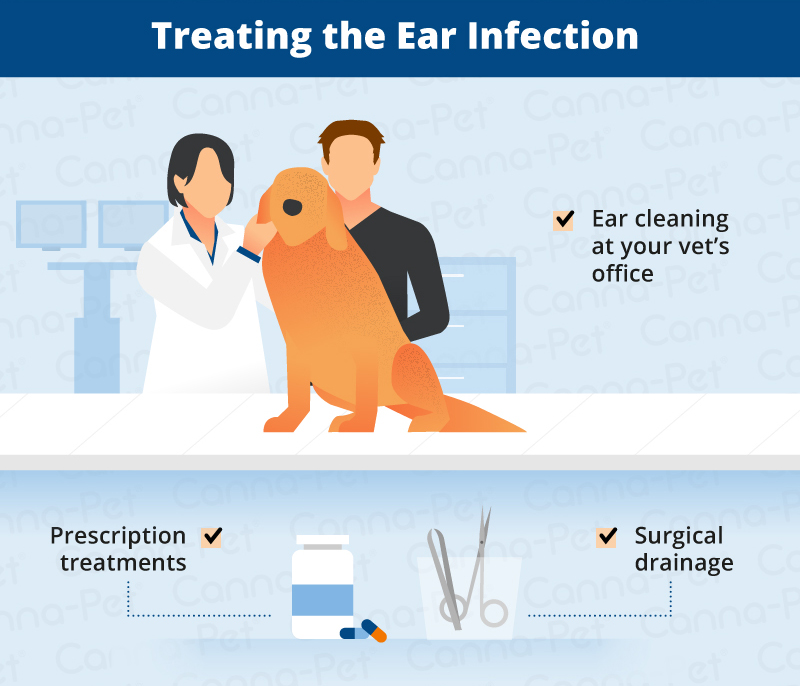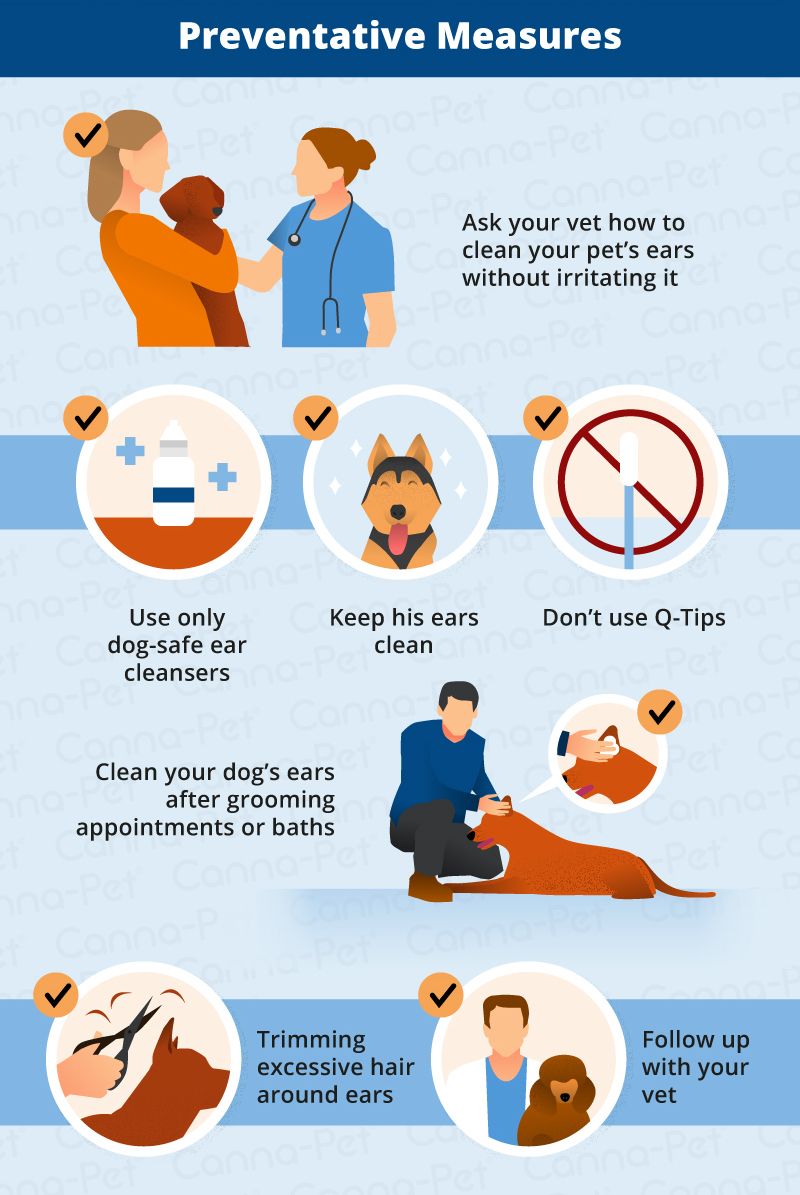When you notice your four-legged friend is suffering from itchy or irritated ears, it’s important to examine him closely to see if it’s time for a trip to the veterinarian’s office. Typically, the result of bacterial or yeast (fungal) infections, ear infections are a common malady that dogs suffer from. However, it’s essential as a pet owner to pay attention to the signs and symptoms of something more serious than a minor itch, as negligence can lead to possible health complications.
Causes of Canine Ear Infections
While bacteria are the primary cause behind ear infections in your dog, only your vet can determine the reason for his discomfort and related illness/condition. Otitis media refers to middle-ear inflammation, while otitis interna refers to inner ear inflammation; both conditions are commonly caused by bacterial infection.
There are a variety of other reasons that your dog may be experiencing inflammation of the middle or inner ear; an excessive amount of hair, moisture or wax build-up can all be contributing factors in the development of an infection. Unlike the horizontal ear canal found in humans, your dog’s ear canal is vertical, making it very susceptible to debris and moisture to enter (and stay trapped inside) his ear canal.
The following is a partial list of specific disease-causing agents, conditions, or underlying causes for canine ear infection:
- Allergies are a common cause for canine ear infections
- Hypothyroidism can lead to a variety of different side-effects, including dry skin, bacterial infections and subsequent chronic ear infections
- Malassezia is a specific strain of yeast that can lead to infection
- Aspergillus is a fungus that is linked to ear infections and inflammation
- Ear mites are another cause of ear infection, increasing the likelihood of bacterial infection (most commonly found in puppies)
- Trauma to the body (such as head injuries suffered in a car accident)
- Presence of tumors or polyps in the ear canal
- Foreign objects in the ear
Recognizing the Symptoms of Dog Ear Infection
Depending on the level of ear infection your dog is experiencing, symptoms may vary a great deal. Your dog’s symptoms may range from a lack of visible symptoms to severe cases where facial paralysis is apparent.
Here are several symptoms that may indicate an infection and require an exam by a professional vet:
- Yellow, brown, or bloody discharge from the ears
- Pain when opening mouth or reluctance to chew
- Scabs or crusting on the inside of the outer ear
- Noticeable hair loss around the ear
- Head tilting/shaking
- Hearing loss/deafness
- Leaning to the side of the affected ear
- Loss of balance/appearance of vertigo
- Abnormal/foul odor emitting from the ear
- Redness or swollen appearance around the ear canal
- Excessive rubbing, pawing or scratching of the ear or surrounding areas; rubbing ears against the floor or furniture
- Unusual eye movements
- Walking in circles
- Nausea or vomiting
- Wobbly or uncoordinated body movements; swinging of the head
- Unequally sized pupils
- A grey bulging eardrum (known as tympanic membrane)
- In severe cases, there are signs associated with nervous system damage indicating facial nerve damage (such as symptoms of paralysis or an inability to blink)
If you notice any of these signs or symptoms, it’s imperative to take your dog to the vet as soon as possible. Not only are canine ear infections very painful, but if left untreated, they can be potentially dangerous, harming both the ear canal and your dog’s middle ear and possibly result in hearing loss.
Are Certain Dogs More Prone to Ear Infections?
Allergies: Although all dogs are susceptible to ear infections, there are several factors which can make your furry friend more prone to this painful and unpleasant condition. For starters, dogs with allergies are prime candidates for ear infections. Due to the microscopic inflammation that allergies cause in the skin of mammals, an overgrowth of bacteria and candida (yeast) can be a breeding ground for dermal conditions, including ear infections.
Canine allergies are actually similar to human allergies, including food and dietary sensitivities; therefore, you may wish to discuss dietary supplements to boost his immune system and choose foods which will cause the least amount of inflammation. Excessive consumption of grain and/or sugar in your dog’s diet is one of the most frequent causes of ear infections in dogs, and is usually notes affecting both ears at once.
The sugars feed the naturally-occurring yeast that live on your dog’s body, creating an overgrowth, which results in the dark colored, yeasty-smelling buildup that can occur inside your dog’s ears. Therefore, selecting the appropriate food options for your pooch can really have an impact on his overall health, including the occurrence or frequency of canine ear infections.
Breed: Another factor that weighs in to a predisposition to ear infections is breed – certain dogs with non-erect outer ears are more inclined to developing ear infections. One of the simplest ways to keep your pup free from infection is to keep water out of his ears, as well as watching for the aforementioned tell-tale signs.
Here is a fairly extensive list of breeds with floppy, non-erect or long ears (also known as pendulous ears) that are prone to ear infections:
- Afghan Hound
- Basset Hound
- Beagles
- Bloodhound
- Bull Mastiff
- Cavalier King Charles (high rate of a condition known as “glue ear”)
- Cocker Spaniel
- Coon Hound
- Dachshund
- Doberman (if ears are not cropped)
- Great Dane
- Newfoundland
- Saint Bernard
- Shih Tzu
- Springer Spaniel
- Weimaraners
Other canines that are apt to get ear infections include swimming breeds such as Labradors, Golden Retrievers, Poodles, and Portuguese Water Dogs. Additionally, owners of dogs with hairy inner ear flaps (such as Schnauzers and Miniature Poodles) should also pay special attention to signs of infection.
Helpful tip: For dogs who suffer from frequent scabbing or minor ear infections due to floppy, non-erect or long ears, apply a generous amount of thick calendula cream, Aquaphor baby ointment, or other moisture-rich, dog-safe lubricating cream to keep the tips of your pooch’s ear flaps softened while reducing the build-up of scabs and irritation. If you’re uncertain as to which product to use, consult with your vet for pet-friendly recommendations.
Diagnosing Canine Ear Infection: What To Expect
Once you’ve brought your dog to the vet, he or she can usually determine whether or not your pup has an ear infection by examining the ear canal and ear drum with a device known as a magnifying ear cone (similar to the instrument used to examine people). If your dog is displaying signs that he’s in pain, your vet may administer sedation to examine his ears.
Your vet may also require a sample of ear discharge to ascertain the cause of his infection, looking specifically for signs of bacteria, yeast, and parasites. There are a number of factors that may be the cause, including ear mites (found particularly in puppies), foreign bodies, and even hypothyroidism, as mentioned earlier.
Once your vet has established the presence of infection, he may send a sample of the discharge to a laboratory to verify the cause. Your vet may also run other tests and diagnostics to check for other possible causes, such as an underactive thyroid. Since there are many possible causes and factors for your dog’s ear infection, it’s imperative that your vet run a thorough battery of tests to rule out every possible catalyst.
Treating Your Dog’s Ear Infection: How to Care For Your Pet
In most cases, canine ear infections can be treated with a cleaning at your vet’s office followed up with prescription treatments at home. Your vet may prescribe oral and/or topical medications, so it’s important to follow dosage information and ask any questions when administering meds to your pet.
Depending on the severity of your dog’s ear infection, treatment methods may vary. If his ear infection has become debilitating, your vet may require your dog to be kept in the hospital for additional treatment, rehabilitation, and assessment for possible neurological symptoms. Once he’s in stable enough condition to be released, your pooch will require a follow-up visit about two weeks after treatment to ensure he has fully recovered.
In the instance of milder ear infections, your dog can be treated at home with different medications; antimicrobials are commonly prescribed to fight the bacterial infection. Typically, these infections are resolved with aggressive antibiotic therapy if caught early on and won’t recur; however, if your dog is prone to recurrent ear infections, he may be a candidate for surgical drainage.
You may also choose to explore holistic methods of treating your dog’s ear infections. Some experts believe blending both holistic treatments and conventional medicine – such as using steroids like Prednisone to initially break the cycle of infections, and then incorporating a holistic approach that examines your dog’s diet, lifestyle and overall health – as a long-term cure for your dog’s condition.
However, as in every form of treatment, it’s important to consult with your vet before administering any type of solution, pill, medication, or ointment, even if it is touted as ‘organic’ or ‘all-natural’.
Methods of Prevention: Proactive Measures to Guard Against Ear Infection in Dogs
As the old adage goes, “knowledge is power” – once you and your vet have determined the underlying cause of your pup’s ear infection, it’s much easier to treat him moving forward. However, taking a proactive approach in your dog’s grooming routine is essential to preventing future chances of infection. Keeping that in mind, it’s helpful to identify the different reasons why your dog is getting these infections in the first place.
As we’ve mentioned earlier, bacterial and fungal infections can result in irritations – but they usually originate from your dog’s day to day activities in the events where his ear canals become moist – usually from bathing, swimming or grooming. Therefore, keeping his ears and the surrounding areas clean and dry is one of the most effective methods of preventing infection. However, there are instances where there may be an underlying medical condition, in which case a trip to the vet is advised.
Because it is not uncommon for certain dogs to experience recurrent ear infections, being mindful of preventative measures can make a huge difference in your furry friend’s health. Although routine ear cleaning may reduce chances of infection, doing so too frequently or using an overly vigorous technique can be damaging to the ear canal.
Here are some helpful preventative measures to follow for canine ear infection:
- Always consult with your vet first: Follow your vet’s instructions carefully and learn the safest methods of ear cleaning to avoid irritating this sensitive area.
- Play it safe: Use only dog-safe, vet-approved ear cleansers and washes to reduce the frequency of infection, particularly in allergy-prone dogs.
- Be proactive: Routinely cleaning your pooch’s ears after grooming appointments or bathing can help prevent future infections, particularly if they appear dirty. Using a vet-approved product, apply solution with 100% pure cotton balls to gently cleanse your pup’s ears. Your vet can also make professional recommendations regarding how frequently you should clean your dog’s ear area.
- Keep him dry: Be sure to keep your dog’s ears dry – whether he’s just out of the bath, exposed to inclement weather or was freshly shampooed at the groomer, carefully pat his ears and the surrounding areas dry, particularly if he’s prone to recurring infections, suffers from allergies or falls under the category of breeds predisposed to ear infections.
- Keep him groomed properly: For dogs who have excessive hair in the outer ear canal, you may wish to leave trimming to a professional groomer. However, if you feel confident, you can ask your veterinarian to show you the proper way to remove the hair.
- Never use Q-Tips: When cleansing your dog’s ears, never use ear swabs, as they may push debris further into the ear canal and possibly rupture his eardrum. In addition, avoid rubbing alcohol or other solutions – use only treatments that have been specifically prescribed by your vet when administering care at home.
- Follow up with your vet: If you don’t notice improvement within the projected time of recovery or your dog’s condition worsens, contact your veterinarian immediately.
Sources:
- “Ear Infections in Dogs: Symptoms, Causes and Treatments.” Cesar’s Way, 21 July 2016, Accessed 8 Feb. 2017. www.cesarsway.com/dog-care/ear-care/ear-infections-in-dogs-symptoms-causes-and-treatments.
- “Ear Infections in Dogs: Symptoms and Treatment.” WebMD, Accessed 8 Feb. 2017. www.pets.webmd.com/dogs/dog-ear-infections.
- “Ear Infections In Dogs: Symptoms, Causes, Treatment, And Prevention.” Dogtime, 23 July 2018, Accessed 8 Feb. 2017. www.dogtime.com/dog-health/743-causes-and-treatments-of-dog-ear-infections-aaha.
- “Dog Ear Infections: Symptoms, Causes, Treatment, and Prevention – American Kennel Club.” American Kennel Club, 24 Nov. 2015, Accessed 8 Feb. 2017. www.akc.org/expert-advice/health/dog-ear-infections/.
- “Chronic Otitis/Chronic Ear Infections in Dogs.” Vetstreet, Nov. 2011, Accessed 8 Feb. 2017. www.vetstreet.com/care/chronic-otitis-chronic-ear-infection-in-dogs.


